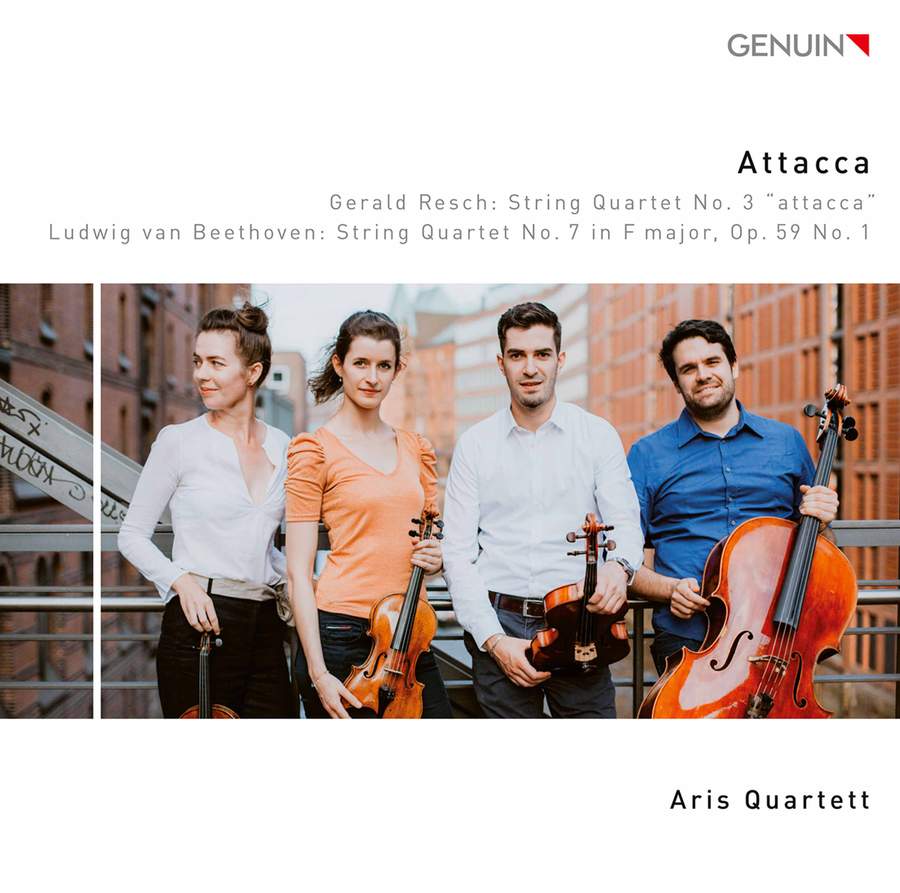Gerald Reschs Streichquartett Nr. 3 (Attacca), im Auftrag des Wiener Musikvereins komponiert, aber letztlich in der Paul Sacher Stiftung in Basel uraufgeführt, entstand, wie der Komponist betont, nach ausführlichen Vorbereitungsgesprächen mit dem Aris Quartett, welches sich ausdrücklich einen Bezug zu Beethoven wünschte.
Das 22 Minuten dauernde Stück hat vier ineinander übergehende Teile. Es ist ein bewegungsintensives Werk, sehr rhythmisch, bis hin zu motorisch. Zum zweiten Satz sagt der Komponist: « Im Hauptteil des 2. Satzes zitiere ich den bizarren Beginn des 2. Satzes aus Beethovens Streichquartett op. 59/1: eine charakteristisch rhythmisierte Tonwiederholung im Cello, aus der sich alles Folgende in Art eines Perpetuum mobile ableitet ». Das Aris Quartett arbeitet entsprechend viel und zupackend in diesem Werk, dem auf der CD logischerweise das zitierte Beethoven-Quartett folgt. Und Opus 59 macht auch insofern Sinn, weil in diesem Set der Keim all des Neuen und Innovativen deutlich wird, das Beethoven in den Spätwerken zur Vollendung bringen sollte. Dieser Aufbruch wird beim Aris Quartett sehr deutlich.
Die vier Musiker verstehen es, aufeinander zu hören und gemeinsam die Musik weiterzuführen, sie als Austausch zu sehen und dabei sowohl die gedankliche Tiefe wie auch die emotionale Komponente nicht außer Acht zu lassen.
Gerald Resch’s String Quartet No. 3 (Attacca), commissioned by the Vienna Musikverein, but ultimately premiered at the Paul Sacher Foundation in Basel, was written, as the composer points out, after extensive preparatory discussions with the Aris Quartet, which specifically requested a reference to Beethoven.
The 22-minute piece has four parts that merge into one another. It is an animated and intensive work, very rhythmic to the point of being motoric. Regarding the second movement, the composer says: « In the main part of the 2nd movement, I quote the bizarre beginning of the 2nd movement from Beethoven’s String Quartet Op. 59/1: a characteristically rhythmic repetition of notes in the cello, from which everything that follows is derived in the manner of a perpetuum mobile. » The Aris Quartet’s playing is accordingly intense and gripping in this work, which is logically followed on the CD by the quoted Beethoven Quartet. And Opus 59 also makes sense in that it contains the germ of Beethoven’s innovative ideas, that would reach perfection in the late compositions. This becomes very evident with the Aris Quartet.
The four musicians know how to listen to each other and to develop the music together, to see it as an exchange and yet not to disregard the depth of thought as well as the emotional component.




















